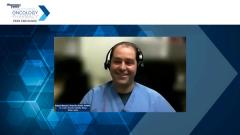
RRMM: Adopting Anti-BCMA Therapy into Practice
Robert Mancini, PharmD, BCOP, FHOPA, of St. Luke’s Cancer Institute: Boise, comments on his experience navigating challenges using belantamab mafodotin, an anti-BCMA therapy, to treat relapsed/refractory multiple myeloma.
Episodes in this series

Bhavesh Shah, RPh, BCOP: I can definitely share all the challenges we went through—bringing this drug on formulary, in terms of collaborating with the ophthalmologists and optometrists and putting together a workflow around managing every patient. Because we’re not used to doing this in myeloma.
There are no other providers involved in managing the patient and letting us know where they are in terms of the toxicity profile so we can make the treatment decisions. We’re assessing the toxicities and which doses they will be receiving. You made a great point that this continues to work, even if you’re holding and adjusting the dose, this is dose dependent. It’s really important for the audience to understand that. Robert, you said you were actually the lead. We want to hear some of your challenges and how you overcome those in your practice and implement this drug.
Robert Mancini, PharmD, BCOP, FHOPA: I serve as the AR, or authorize representative, for the REMS [Risk Evaluation and Mitigation Strategies] program. We have other pretty intensive REMS programs in myeloma with IMiDs [immunomodulatory imide drugs] and the associated components of that. As you said, Bhavesh, 1 of the big things is that we can manage all that within the cancer center as opposed to relying on someone who might be outside. For us, we don’t have comprehensive services, similar to the larger centers like Emory Healthcare where Ryan Haumschild is. But we have to rely on a disconnected relationship with providers outside our health system. What we’ve found has really helped with that, and there are serval issues that we have to deal with in these patients.
First, you have to find an eye care professional, whether it’s an ophthalmologist or an optometrist, as you mentioned, Ryan. Then there’s insurance. Is the patient’s insurance going to pay for what we recommend because we’ve worked with them on this drug? The third is whether the patient has a comfort level. Some of our patients already have an established eye care professional that they would prefer to stay with. We talked about COVID-19 a little earlier. We had some issues when [belantamab mafodotin] hit the market because some providers or eye care professionals weren’t accessible to get someone in within a week or less because they have restrictions based on COVID-19. Either their clinic was shut down or they’re not seeing as many patients to help manage social distancing. We’ve had to find some ways to work around all 3 of those issues.
REMS programs in general should always be a coordination between the health care setting and the drug manufacturers. It shouldn’t be, “You guys figure this out.” At least with the belantamab mafodotin, we’ve seen good coordination, with the company in helping us navigate that issue. If we’re finding eye care professionals in that community setting, that’s help that they can provide. Because we don’t know. Then you also have legal issues.
Sometimes, if you are referring to a specific entity and there are conflicts of interest, you know when you’re not all in that same system. We’ve had to deal with some of that. But as you’ve said, when [belantamab mafodotin] hit the market, we had all these patients who were like, “This is great.” Then they see the REMS program, and some of our docs are like, “No way, I’m not using that.” Just because it seemed so complicated. From my own experience, it looks daunting. But once I got into it and I started working with it—again, they’ve made modifications, they’ve listened to our feedback on how we get this fixed. So far it’s not as bad as I thought it was going to be. Once you get into it and once you get it set up, it’s pretty easy to navigate.
Transcript edited for clarity.
Newsletter
Stay informed on drug updates, treatment guidelines, and pharmacy practice trends—subscribe to Pharmacy Times for weekly clinical insights.















































































































































































































